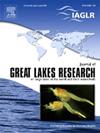New tools for a legacy problem: How isotope tracers inform area of concern actions in the St. Louis River in Lake Superior
IF 2.4
3区 环境科学与生态学
Q3 ENVIRONMENTAL SCIENCES
引用次数: 0
Abstract
Numerous mercury (Hg) sources can contribute to biological burdens within the Great Lakes, including atmospheric deposition (e.g., precipitation), non-point source land runoff (e.g., watershed), and legacy contamination. Due to these different environmental entry points, it is often difficult to ascertain if legacy Hg contamination contributes to contemporary fish consumption advisories within Areas of Concern (AOCs), as designated by the United States-Canada Great Lakes Water Quality Agreement. In this study, we aimed to assess the contributions of legacy Hg to sediments in nearshore wetland habitats and co-located prey items (dragonfly larvae and yellow perch) within the St. Louis River AOC using Hg stable isotopes. We observed that nearshore sediments had the same Hg source portfolio as previously examined main channel sites. Furthermore, this data confirmed that two major Hg sources were contributing to sediments within nearshore regions of the St. Louis River AOC: legacy and watershed Hg. The contribution of legacy Hg was estimated in biota and demonstrated that up to 64% of the Hg in fish tissue in the lower estuary (St. Louis Bay) was from legacy sources, but that this percentage declined substantially when examining upstream regions of the AOC. These data indicate the influence of legacy Hg to the food web varies spatially within the St. Louis River. We further found that watershed Hg sources are an important Hg contributor to the St. Louis River, which likely applies to other impacted and unimpacted tributaries across the Great Lakes region.
遗留问题的新工具:同位素示踪剂如何告知苏必利尔湖圣路易斯河关注区域的行动
众多汞(Hg)源可造成五大湖内的生物负担,包括大气沉降(如降水)、非点源土地径流(如流域)和遗留污染。由于这些不同的环境切入点,通常很难确定遗留的汞污染是否影响了美国-加拿大大湖水质协议指定的关注区域(AOCs)内的当代鱼类消费咨询。在这项研究中,我们旨在利用汞的稳定同位素来评估圣路易斯河AOC内近岸湿地栖息地和同地猎物(蜻蜓幼虫和黄鲈)中遗留汞对沉积物的贡献。我们观察到近岸沉积物的汞源组合与之前研究的主要河道相同。此外,该数据证实了两个主要的汞源对圣路易斯河AOC近岸区域的沉积物有贡献:遗留汞和流域汞。对生物群中遗留汞的贡献进行了估计,并表明河口下游(圣路易斯湾)鱼类组织中高达64%的汞来自遗留汞源,但在AOC上游区域进行研究时,这一比例大幅下降。这些数据表明,遗留汞对圣路易斯河内食物网的影响在空间上是不同的。我们进一步发现,流域汞源是圣路易斯河的重要汞贡献者,这可能适用于五大湖地区其他受影响和未受影响的支流。
本文章由计算机程序翻译,如有差异,请以英文原文为准。
求助全文
约1分钟内获得全文
求助全文
来源期刊

Journal of Great Lakes Research
生物-海洋与淡水生物学
CiteScore
5.10
自引率
13.60%
发文量
178
审稿时长
6 months
期刊介绍:
Published six times per year, the Journal of Great Lakes Research is multidisciplinary in its coverage, publishing manuscripts on a wide range of theoretical and applied topics in the natural science fields of biology, chemistry, physics, geology, as well as social sciences of the large lakes of the world and their watersheds. Large lakes generally are considered as those lakes which have a mean surface area of >500 km2 (see Herdendorf, C.E. 1982. Large lakes of the world. J. Great Lakes Res. 8:379-412, for examples), although smaller lakes may be considered, especially if they are very deep. We also welcome contributions on saline lakes and research on estuarine waters where the results have application to large lakes.
 求助内容:
求助内容: 应助结果提醒方式:
应助结果提醒方式:


